![]()
![]()
![]()
Use LEFT and RIGHT arrow keys to navigate between flashcards;
Use UP and DOWN arrow keys to flip the card;
H to show hint;
A reads text to speech;
40 Cards in this Set
- Front
- Back
|
7Th Century CE |
600-699 CE |
|
|
7th century BCE
|
699-600 BCE |
|
|
C.before date |
Circa, or approximately |
|
|
C.after date
|
Century |
|
|
BCE |
Before common era |
|
|
CE
|
Common era (the time Jesus Christ was born. |
|
|
BP |
Before the present |
|
|
PALEOLITHIC AGE -Lower paleolithic |
* 2,000,000-100,000 BCE |
|
|
PALEOLITHIC AGE -Middle paleolithic |
*100,000-40,000 BCE |
|
|
PALEOLITHIC AGE -Upper paleolithic |
*40,000-10,000 (8,000) BCE |
|
|
MESOLITHIC AGE |
*10,000(8,000)- 8,000(6,000) BCE |
|
|
NEOLITHIC AGE |
*8,000(6,000)- 3,000(2,000) BCE |
|
|
Aeagan:Minoan |
(c.1900-1700 BCE)
|
|
|
Minoan (Second Palace) |
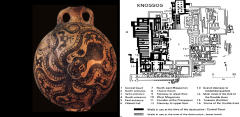
(c. 1700-1450 BCE) *1st: Octopus Vase, from Palaikastro, Crete. Second palace period, Marine style ceramic, 28 cm, ca. 1500 BCE *2nd: Knossoss "Palace" diagram |
|
|
Late Minoan (c. 1450-1375 BCE) |
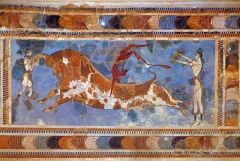
(c. 1450-1375 BCE) *Bull Leaping, from the palace complex, Knossos, Crete. ca. 1550–1450 BCE (restored), 62.3 cm
|
|
|
Prehistoric Art & Architecture |
*Carved Figures *Cave/rock paintings *Megalithic architecture |
|
|
Neolithic |
Relating to, or denoting the later part of the Stone Age, when ground or polished stone weapons and implements prevailed. |
|
|
Sculpture in the Round |
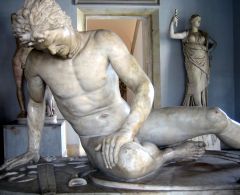
a type of sculpture in which the figures are presented in complete three-dimensional form and are not attached to a flat background (unlike relief). |
|
|
High Relief |
a sculptural relief in which forms extend out from the background to at least half their depth. |
|
|
Incise |
mark or decorate (an object or surface) with a cut or a series of cuts. |
|
|
Memory Image |
a mental image of something previously experienced |
|
|
Abstraction |
freedom from representational qualities in art. |
|
|
Flourished |
Grow or develop in a healthy or vigorous way, especially as the result of a particularly favorable environment. |
|
|
Reign |
Rule as king or queen |
|
|
Paleolithic |
Relating to, or denoting the early phase of the Stone Age, lasting about 2.5 million years, when primitive stone implements were used. |
|
|
Upper Paleolithic art example |
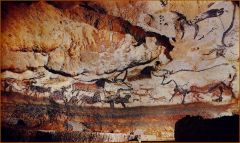
*Hall of Bulls, Cave of Lascaux, France, c. 15,000- 13,000 BCE, Paint on limestone *It was said that hunters painted animals in a way in which every body part is seen, as is. *Hunters painted animals as a way of ritual, where is one believes that this animal will be hunted, it will become reality. |
|
|
Mesolithic |
Relating to, or denoting the middle part of the Stone Age, between the Paleolithic and Neolithic. |
|
|
Low Relief |
a sculptural relief in which forms extend only slightly from the background |
|
|
Megalithic/cromlech/mortise-and tenon joints |
of, relating to, or denoting prehistoric monuments made of or containing megaliths (a very large usually rough stone used in prehistoric cultures). |
|
|
Corbelling/Corbel |
support (a structure such as an arch or balcony) on corbels. |
|
|
Upper Paleolithic art example |
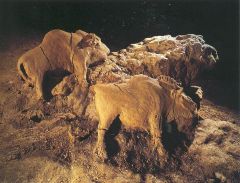
*Two bison, Le Tuc d'Audoubert Cave, Ariege, France. Ca. 13,000 BCE. clay, length 60 cm |
|
|
Relief |
To create a sculpture in relief is to give the impression that the sculpted material has been raised above the background plane. |
|
|
Middle Paleolithic art example |
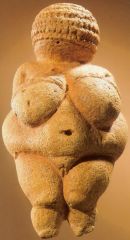
*Woman(venus) from Willendorf, c. 22,000 BCE, Limestone 1 3/4"
|
|
|
Post and Lintel Construction |
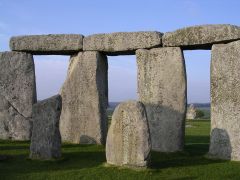
In architecture, post and lintel (also called prop and lintel or a trabeated system) is system with a lintel, header, or architrave as the horizontal member over a building void supported at its ends by two vertical columns, pillars, or posts. |
|
|
Mesolithic art example |

*Figures, from Ain Ghazal, Jordan. C. 7000-6000 BCE. Clay plaster with cowrie shell, bitumen, and paint, height approx. 35” (90cm) Applied wet plaster to reed – and cord frames in human shape, the eyes were inset cowerie shells, small dots of black, tar-like substance bitumen, stood upright
|
|
|
Middle Paleolithic art example |
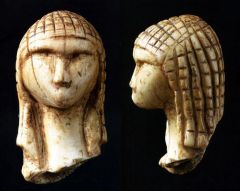
*Woman of Brassempouy, Grotte du Pape, brassempouy, France. ca. 22,000 BCE. Ivory Height 3.6 cm |
|
|
Neolithic art example |
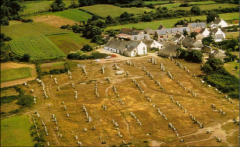
*Menhir alignment at Menec, Carnac, France. Ca. 4230-3750 BCE
|
|
|
Neolithic and Bronze age art example |
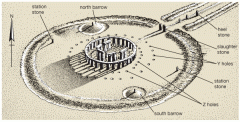
*Stonehenge, Salisbury Plain, Wiltshire England, c. 2750 - 1500 BCE |
|
|
Neolithic art example |
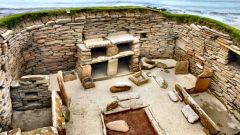
*Interior, Skara Brae, Orkney Islands, Ireland, c. 3,100 BCE
|
|
|
Historical Divisions of Greek Art
|
-Proto geometric (c. 1000-900 BCE) |

